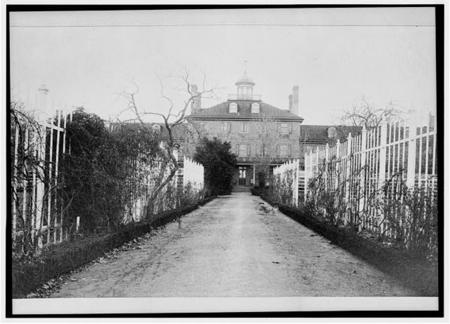My favorite song about punctuation is currently Oxford Comma, by Vampire Weekend, a group that I know about because the lead singer, Ezra Koenig, took a Melville seminar I taught a couple of years ago and sent out an all-points bulletin this summer about his band’s shows in Brooklyn. Anyway, it’s very catchy, and in the past few months it’s migrated into my high-frequency playlist. According to the band’s website, it’ll be on an EP that comes out next month.
Lazaretto rises from dead, maybe
A couple of weeks ago I wrote about the Lazaretto, an 18th-century quarantine house in Tinicum, a small township just outside of Philadelphia, which was in danger of being eclipsed by a new fire-station/conference center complex. News about it seemed to have dried up, and I wondered if the story was over.
It wasn’t, as it turns out.
Ground was broken on the site sometime after September 11, and in late October, two historic preservation groups asked a Delaware County judge to stop the construction. Yesterday, November 9, the preservationists and Tinicum officials reached an out-of-court settlement. The township will continue to build its firehouse on the site, but the two sides will appoint nine members to a board that will manage a new nonprofit in charge of the five acres that the Lazaretto sits on. In addition, part of the firestation’s parking lot will be turned into a buffer zone.
As with most compromises, this sounds less than ideal. It doesn’t sound as if the long vista in front of the Lazaretto will be preserved, and it’s the sort of 18th-century building that insists on being approached down a long lane. In fact, since the firehouse is to stand between the Lazaretto and the access road, it’s not clear how the public would reach the Lazaretto at all, unless they’re arriving by boat; presumably they will come through the firehouse’s parking lot, not the most inspiring entry. For that matter, if you look at the blueprint for the firehouse, and mentally amend it by making half the parking lot into a buffer zone, it’s not clear that the preservationists have won much. If it’s to be built at anything like its originally projected size, the firehouse will
still dwarf and obscure the Lazaretto.
M-O
A couple more echoes of Mass-Observation. New Yorkers have a chance to see Rebecca Baron’s documentary on the movement, How Little We Know of Our Neighbours, this Sunday, November 12, at 4pm, at the American Museum of Natural History, Central Park West at 79th Street.
And Emily Gordon alerts me to a new Mass-Observation–inspired art project, involving the collection of pennies and the stories implied by them.
AWOL
I’m going to be AWOL from the Internet for a week or so, and there won’t be any new posts here for a little while.
An 18th-century Ellis Island, saved and lost
In 2000, a developer bought a 10-acre plot of land on the bank of the Delaware River in Tinicum Township, not far from Philadelphia’s airport, with the intention of paving it into a parking lot. Surviving on the site through a century of benign neglect was a quarantine house known as the Lazaretto, built in the late 1790s for yellow fever patients and used until 1893 as an immigrant processing center—like Ellis Island, but a century older. The Federalist-era building, seen here in a 1936 photograph in the Historic American Buildings Survey (survey number HABS PA-125), still stands, and still looks pretty good in current photographs. In 2001, local preservationists raised a stink about the proposed parking lot, and the Commonwealth of Pennsylvania gave Tinicum Township several million dollars to keep the site intact. This spring, however, it emerged that the township’s preservation plan is to build an enormous fire station/evacuation center on the property. The Lazaretto building won’t be destroyed, but it will be more or less engulfed in the firehouse’s embrace. The National Park Service, among others, protested. The preservationists wanted to turn the site into an Ellis Island-style museum and historic center, but they seem to have run out of time. The township awarded the construction project to a contractor in late August; groundbreaking was scheduled for September 11. I haven’t heard whether the ground has in fact been broken, though.
Throughout the debate over the Lazaretto, tempers have run high and short. The preservationists have raised questions about the town’s choice of how to use the state funds, and have suggested that the evacuation center is a boondoggle (i.e., that its real purpose is as a moneymaking banquet hall/conference center) and that breaking ground will unearth pathogens from yellow fever victims buried there. The town’s manager resigned mid-summer, though it’s not clear that he resigned over this issue. One of the town’s commissioners, however, did issue a statement in July defending the firehouse plan from meddling outsiders. Tinicum’s officials seem to feel that they’re being punished now for their good deed four years ago of saving the site from becoming a parking lot, and they suggest that if they hadn’t alerted the preservationists early on, they could have built their firehouse unimpeded. To judge from the comments on the preservationists’ website, there are some local residents who agree, and others who are upset that a historic site is being rendered inaccessible to the public so soon after it was rediscovered.

